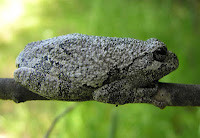This time of year you’ll hear a long high pitched trill at
night in the woodlands. This is the
mating song of the gray treefrog (Hyla
versicolor). Only about 2 inches
long, this little critter comes in a variety of colors from gray, green or
brown, solid or with blotches. There is
always a large, white marking below each eye. The inside of each hind leg is a
bright yellow-orange. Its strategy for
survival lays in its ability to quickly change colors to match its
surroundings. It has large sticky toe
pads that help it cling to tree bark and other surfaces. This little frog doesn’t live in a pond but
in the trees or shrubs. There it spends
the day resting. At night it crawls
among the branches and leaves looking for moths, tree crickets, ants or other
insects. It can be very acrobatic in its
search. However in late May or early
June, it will descend down to woodland pools looking for a mate. The female, who is much larger than the male,
does not sing but will select a mate based on its call. Each female can lay as many as 2,000 eggs in
groups of 10 – 40 on vegetation near the water’s surface. It takes about 2 months for the tadpoles to
fully change into frogs. During the
winter, these frogs hibernate under the leaf litter, bark or rocks. Like its cousin the wood frog, it will freeze
solid. From the glycerol in its system,
it can produce antifreeze which protects its cells from the freezing
process. Even though its heart and
breathing stop, come spring it will thaw out and return to the trees. There it will hunt until the nights warm up
to 60°F when it will fill the woodlands with its song once more. Photo:
beauty-animal.blogspot.com
Tuesday, May 28, 2013
Subscribe to:
Post Comments (Atom)





No comments:
Post a Comment